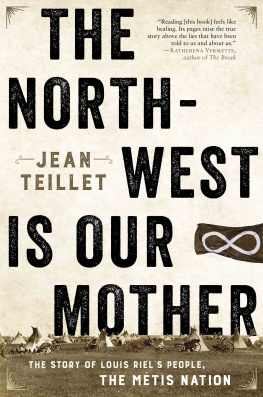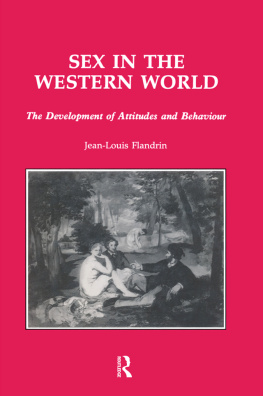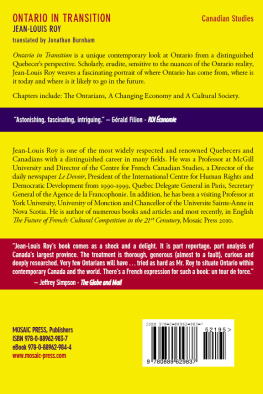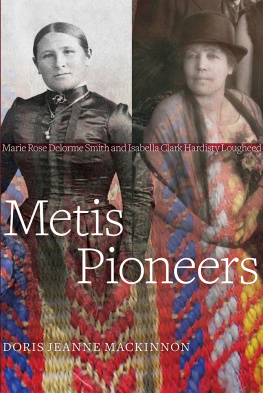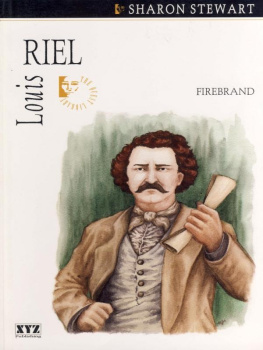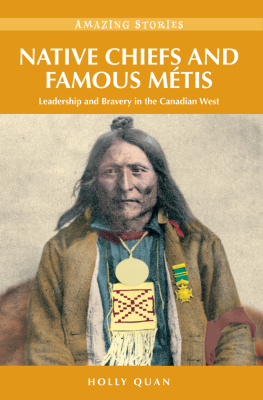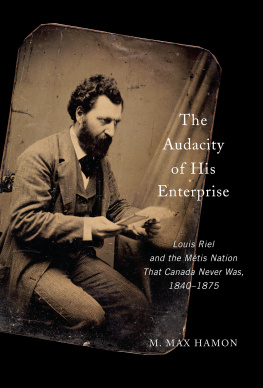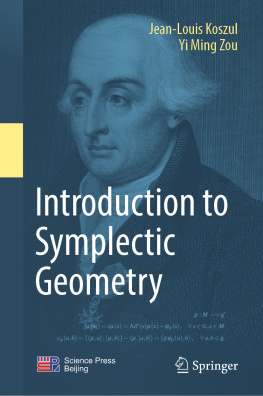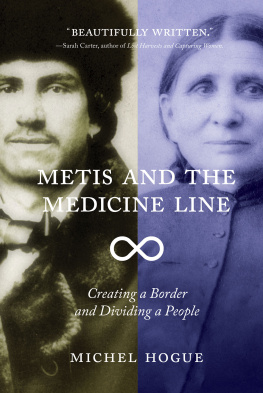Jean Teillet - The North-West Is Our Mother: The Story of Louis Riels People, the Metis Nation
Here you can read online Jean Teillet - The North-West Is Our Mother: The Story of Louis Riels People, the Metis Nation full text of the book (entire story) in english for free. Download pdf and epub, get meaning, cover and reviews about this ebook. year: 2019, publisher: HarperCollins Canada, genre: Romance novel. Description of the work, (preface) as well as reviews are available. Best literature library LitArk.com created for fans of good reading and offers a wide selection of genres:
Romance novel
Science fiction
Adventure
Detective
Science
History
Home and family
Prose
Art
Politics
Computer
Non-fiction
Religion
Business
Children
Humor
Choose a favorite category and find really read worthwhile books. Enjoy immersion in the world of imagination, feel the emotions of the characters or learn something new for yourself, make an fascinating discovery.
- Book:The North-West Is Our Mother: The Story of Louis Riels People, the Metis Nation
- Author:
- Publisher:HarperCollins Canada
- Genre:
- Year:2019
- Rating:3 / 5
- Favourites:Add to favourites
- Your mark:
- 60
- 1
- 2
- 3
- 4
- 5
The North-West Is Our Mother: The Story of Louis Riels People, the Metis Nation: summary, description and annotation
We offer to read an annotation, description, summary or preface (depends on what the author of the book "The North-West Is Our Mother: The Story of Louis Riels People, the Metis Nation" wrote himself). If you haven't found the necessary information about the book — write in the comments, we will try to find it.
Jean Teillet: author's other books
Who wrote The North-West Is Our Mother: The Story of Louis Riels People, the Metis Nation? Find out the surname, the name of the author of the book and a list of all author's works by series.
The North-West Is Our Mother: The Story of Louis Riels People, the Metis Nation — read online for free the complete book (whole text) full work
Below is the text of the book, divided by pages. System saving the place of the last page read, allows you to conveniently read the book "The North-West Is Our Mother: The Story of Louis Riels People, the Metis Nation" online for free, without having to search again every time where you left off. Put a bookmark, and you can go to the page where you finished reading at any time.
Font size:
Interval:
Bookmark:
Contents
For all those who have dedicated their lives to the Mtis Nation
The North-West is also my mother, it is my mother country...
and I am sure that my mother country will not kill me...
because a mother is always a mother...
Of all the things on earth, the motherland is the most important
and sacred to us because we inherited it from our ancestors.
L OUIS R IEL
Contents
THE PEOPLE
This is a history of one of the Indigenous peoples of the Canadian North-West, the Mtis Nation. Canadians are generally familiar with one of the Mtis Nations great leaders, Louis Riel. Most know Riel was hanged for treason; very few can articulate what Riel did that was so wrong. For some, references to the Mtis raise foggy recollections from school history lessons about the voyageurs, the fur trade and the buffalo hunters. But how that history ties together with the Mtis is a mystery for most. Who are the Mtis anyway? Arent they just people who have some Indian ancestry? What makes them a nation? Are they still around? The answers to all of these questions are in this book.
This narrative begins in the 1790s and follows the Mtis Nations history right up to 2018. For over two hundred years, the Mtis Nation has insisted on its existence as an Indigenous people and a nation. Throughout those two centuries, the Mtis Nation has foughton the battlefield, in the courts and at the negotiation tablefor recognition, protection of their lands and resources, and for their very existence. Their long battle is also central to the development of Canada, particularly in the North-West.
Despite this, confusion remains about who they are. While Louis Riel has retained a prominent place in the Canadian imagination, the low historical profile of his people remains an intriguing quirk of Canadian history. In some ways this is because the people in this history walked lightly on the land, at least in terms of their physical effect on the geography. Lii vyeu, their old ones, left little physical evidence behind other than beautiful fabrics decorated with thread, quills and beadsuntil recently, nothing the curators of the worlds museums would call art. They left monuments dedicated to their heroes, and some of their cart tracks are still visible in a few places. But with few exceptions the physical structures the old ones built have returned to the earth. Until the twentieth century theirs was an oral culture, so most of what remains are songs, dances and stories.
The Mtis lived lives of constant movement, and their songs and stories reflect that mobility. Their songs are celebrations, satiric comments or laments. Their stories contain little reflection or contemplation. Most of the stories the Mtis tell and retell are the stories of their own history. Today they delight in placing their direct ancestors into the old stories. They introduce themselves proudly as descendants of their famous heroesas a Dumont, Lpine, Grant or Riel. Referencing their ancestors places them instantly in the Mtis Nations historiography. This is how the Mtis Nation defines its citizens. Their stories and their motherland form the demarcation line between those who are of the Mtis Nation and those who are not. Only the descendants of those who lived those stories within the geographic boundaries of their motherland are part of the historic Mtis Nation.
THE PLACE
The North-West is the birthplace and motherland of the Mtis Nation. The historic North-West was more of a perspective than a geographic place with fixed boundaries. The name provokes one to ask, North of what? West of where? The North-West was always the land north and west of Montreal. As the centuries passed the North-West shifted and shrank, always farther north and farther west. By the time the first generation of the Mtis Nation was being born in the 1790s, the North-West began at the height of land west of Lake Superior.
In the 1790s the North-West was an endless stretch of land with delicious food, clean water and rich resources. The lakes and rivers were the highways. The furbearers in the forests and the great herds of buffalo on the Plains were gifts from the land. The parklands and boreal forest provided shelter, water, wood, fish and meat. The old ones thought of the North-West as a mother who protected them and provided for them. They called the North-West their motherland. She was a thousand miles of plenty and in her hands she held the storehouses of the good God.
THE SOURCES
In the traditional way of the Mtis, I place myself into the Mtis Nations historiography and introduce myself. I come from three Mtis Nation families. I am a Riel, a Poitras and a Grant. I am a great-grandniece of Louis Riel. My paternal grandmother was Sara Riel. Saras father, my great-grandfather, was Joseph Riel, Louis Riels younger brother. Saras mother, my great-grandmother, was Eleanor Poitras, the granddaughter of Cuthbert Grants sister Marguerite. I was born in Red River, as were several generations of my family. Every generation of my family has played a role in the stories and history of the Mtis Nation. As one of the Mtis Nations legal warriors and in writing this story, I too am playing my part in the ongoing history of the Mtis Nation.
Some of what I have written in these pages comes from my family stories. I was raised to be proud of being a Rielvery proudand that was at a time when most Canadians viewed the Mtis as dirty drunks and Riel as a treasonous madman. Some of what I know also comes from family papers. While many of those papers are now in the public archives, some remain within the family and the stories they tell are incorporated into this book.
I write this history also as one of the Mtis Nations lawyers. Over the past twenty-five years, I, along with other Mtis legal warriors, have been putting the history of Canada on trial. As a defence lawyer in many Mtis rights cases, I have litigated the history of the Mtis Nation and in so doing have challenged the accepted history of the settlement of this country. Most of those Mtis rights trials were a contest over access to the lands and resources of the Canadian North-West. Some of what I have learned of the history of the Mtis Nation is informed by my experiences in the courts litigating that history. In the course of preparing for many trials, I have read hundreds of thousands of primary source documents and dozens of expert historical and anthropological reports. I have also conducted over two hundred interviews with Mtis Nation citizens.
One challenge that has become apparent through my litigation experience and in writing this history is that some of this ground has been covered by historians who wrote largely in reliance on primary source documents produced by priests, fur traders, explorers, tourists and the British and Canadian governments. Though many of those documents were written at the time of the event or shortly thereafter, they must be read cautiously, because they rarely tell the Mtis side of the story. The existing records that produced those histories, and the histories themselves, are anything but neutral and unbiased.
One priest called the Mtis the one-and-a-half men... half Indian, half white and half devil. The fact that these versions of history have until very recently been accepted uncritically as the history tells us much about the writers and Canada but little about the Mtis Nation.
Having now drawn attention to these other histories, I lay out my own perspectives. I have tried to present this history from the perspective of the Mtis Nation. I have tried to place myself in the footsteps of the old ones and to walk with them as I tell their stories. In each situation I asked myself: What did the Mtis know at the time? What did they want? What were they thinking? Why did they act as they did? Knowing what they thought and understood, how does this all fit together? What does it tell us about them? It is my contention that the evidence contradicts the message in the standard histories that the Mtis were not a nation, were thoughtless, without morals and lacking in conviction, and were never agents in their own cause. I believe, and it is my hope that this book proves, there is a better way to understand the history of the Mtis Nation, one that is well supported by the evidence in the historical record. The stories in this book are meant to add a Mtis perspective to the Canadian historical knowledge about the Mtis Nation. It is my hope that any errors and any differences of perspective in these stories will initiate a dialogue that will enrich the history of this country. Many fine people contributed to the facts and the perspective in this book, but they are responsible for none of the errors. That responsibility is all mine.
Next pageFont size:
Interval:
Bookmark:
Similar books «The North-West Is Our Mother: The Story of Louis Riels People, the Metis Nation»
Look at similar books to The North-West Is Our Mother: The Story of Louis Riels People, the Metis Nation. We have selected literature similar in name and meaning in the hope of providing readers with more options to find new, interesting, not yet read works.
Discussion, reviews of the book The North-West Is Our Mother: The Story of Louis Riels People, the Metis Nation and just readers' own opinions. Leave your comments, write what you think about the work, its meaning or the main characters. Specify what exactly you liked and what you didn't like, and why you think so.

